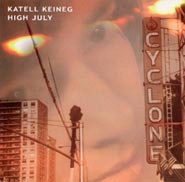Katell
Keineg
High
July
(Megaphone
Music)
Back
in the days when - no MP3s, no downloadable files - critics' opinions
was all that one had to rely upon in order to learn of the existence
of non-MTV-exposed artists, a rave review which appeared in Musician
magazine made me aware of Jet, the new CD by one Katell Keineg. Brilliantly
engineered by John Holbrook, creatively produced by Holbrook, by Keineg
herself and by (former Captain Beefheart sideman and PJ Harvey band
member) Eric Drew Feldman, Jet ('97) was, I soon learned, Keineg's second
full-length album, coming after the critically well-received O Seasons
O Castles (1994). (She had released her debut single - Hestia - on Bob
Mould's SOL record label in 1992).
The
first thing I noticed (and really, it was impossible not to) was Keineg's
voice: an excellent instrument from a technical point of view, but which
was also very versatile and extremely expressive. While most of "side
one" (with the possible exception of Olé, Conquistador)
had been arranged - and sequenced - in a way that didn't exactly prevent
it from being radio-friendly, "side two" (say, starting from
track 7) was an altogether different proposition: quirky, moody, and
definitely on the wrong side of mass acceptance. Still, I reasoned (while
at the same time being perfectly conscious of my being wrong), possessing
that kind of voice could only lead to good things, in commercial terms.
Keineg's
background was definitely "folk music" (and no, let's not
have an argument about what constitutes "folk" right now):
stripped of all those elaborate arrangements that Holbrook and Feldman
had woven around her, it was quite easy to hear a tune carried by guitar
and vocals - not to mention her attitude towards narration (here I immediately
found a stumbling block in the absence of the lyrics in the CD booklet;
but I had the feeling they were quite a bit on the "mysterious"
side). Many listening sessions did not diminish my enjoyment of Jet.
Sure, there were times when I would have liked a bit less production.
But tracks such as Smile, the aforementioned Olé Conquistador,
and those tracks on "side two" (Veni Vidi Vici, Venus, Mother's
Map, Marietta, There You Go) made me curious about what the future held
in store. So I waited.
And
waited. And waited some more. So after a mere seven years (and an EP
- of which I never heard about - released in 2002), it was by chance,
at the end of 2004, that I got to know of the release of High July -
I wonder whether the circumstance of the album being self-financed by
the artist herself and released on a decidedly not-major-and-not-even-minor
label (hey, I couldn't even locate their website!) could have any cause-and-effect
relation with the silence surrounding it. (No, it can't be.)
As
much as I had hoped for a bit less production on parts of Jet, the "sequenced",
hard disk nature of High July, coming after the decidedly "played"
approach of its predecessor, saw me at first a bit puzzled. The vocals
were again excellent, the songs themselves definitely noteworthy. But
the album sounded a touch unadorned till I became familiar with it -
and turned up the volume quite a bit, a thing that makes all those tiny
background parts come within hearing range (but have no fear, the album
doesn't sound any worse than what's currently on the radio), the majority
of the instrumental tracks having been played and arranged by Dim Gurevich.
Opening
track What's The Only Thing Worse Than The End Of Time? starts the album
on an anxiety-inducing tone, with an excellent vocal performance by
Katell Keineg (listen to the way the overdubbed vocals take the tune
out of the bridge and into the chorus) and inscrutable lyrics - "And
A Poster Of 'Francis Ford Coppola Presents Apocalypse Now'"? (Again,
lyrics are not included.) There are some highly contagious fast tracks
(Shaking The Disease, Captain (Steal This Riff)); a fine calypso (Beautiful
Day); those patented very slow tunes (High Marks, On Yer Way) where
she glides up to pitch; the plain-sounding folk tune where little is
revealed (Little Joe). The CD closes with the three most folk-sounding
tracks: Brother Of The Brush, sung in the first person - as Paul Gauguin!;
Seven League Boots, with tuba, accordion and campfire-like background
vocals; and the closing Te Recuerdo Victor Jara, maybe the album's peak
(hear the "group" entrance at 3'33").
As
already noticed, most instrumental parts (with the main exception of
drums and guitars) sound computer-based - check the "minimoog"
on Shaking The Disease and the keyboards on Captain (Steal This Riff)
and Little Joe - but the album never sounds "cold & mechanical".
There are many nice touches that become apparent only after a while
- check (what to me sounds like a) the capoed guitar on High Marks.
Keineg's vocals are always noteworthy. Whether the "folk"
ambience/tag could limit this album's appeal, I don't know. (I know
the "psych-folk" label is quite à la mode these days.
But for a self-financed album?)
Beppe
Colli
©
Beppe Colli 2005
CloudsandClocks.net
| Feb. 20, 2005











